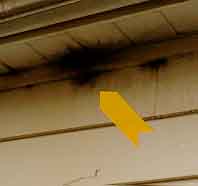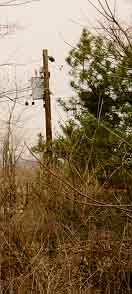LIGHTNING AND IT'S AFTERMATH
by
Charles C. Roberts, Jr.
A lightning stroke is a discharge of electrical energy that usually occurs between clouds and the
earth. As the electrical potential (which may be as high as tens of millions of volts) increases
between the clouds and earth or between two clouds, a lightning stroke often forms. The
currents in a lightning stroke may be on the order of tens of thousands of amperes with a
duration on the order of 100 microseconds. The lightning follows a path of least resistance
which may include people or property. Because of the high electrical currents involved, property
damage and personal injury (or death) are known to occur. The basic behavior of lightning is
not well understood by the scientific community because of the randomness of the lightning
strike and difficulties in making measurements. This adds to the difficulty in analyzing a property
loss allegedly caused by a lightning stroke.



___Figure 1_______________Figure 2______________Figure 3____
Figure 1 is a view of a tree that was struck by lightning. The arrow points to damaged bark that
shows evidence of a path taken by the electrical current from the upper part of the tree to the
ground. The home owner witnessed the strike and indicated that several electronic appliances
failed to function after the storm. Appliance failure can be a result of a direct strike from
lightning or be induced by the strike in the form of a power surge or induced currents in
electronic equipment. When several appliances fail simultaneously, a surge related failure is a
likely cause. However, if only one appliance failed, then other failure modes such as end of life,
vibration, impact, etc., may be a cause.
Figure 2 shows a home where a fire started in the attic just prior to a heavy rain storm. Figure 3
shows severe charring of wood sheathing in the vicinity of a metal plumbing stack at the roof .
Burn pattern analysis (see Claims, Oct. 1987) suggests a fire origin at the interface between the
plumbing stack feed through the roof and the wood sheathing. Analysis of ignition sources ruled
out any other source with the exception of lightning. Apparently, the nature of the strike on the
home was such that sufficient resistive heating occurred at the roof/plumbing vent interface to
ignite wood sheathing.


_____Figure 4_________________Figure 5________

_____Figure 6____
In some situations, a lightning strike can cause current to flow through a building piping system,
causing damage to the interior of the building as opposed to the exterior of the building. Figure 4
is a view of a domestic water heater showing severe arc damage at insulator couplings that
occurred just before a severe thunderstorm. Figure 5 is a close-up of the pipe coupling located
above the insulated union. An insulated union is often placed between pipes of dissimilar metals
to prevent galvanic corrosion (see Claims, Sept. 1993). Apparently, current traveling down the
copper water pipe encountered the high resistance of the insulating coupling, which resulted in
side flash to ground through the metallic structure of the water heater. Several other appliances
were also rendered inoperative as a result of the lightning strike.



_____Figure 7___________Figure 8_____________Figure 9____
Figure 6 is a view of another home showing evidence of high voltage related power dissipation.
Figure 7 shows another view of arc damage to the aluminum siding. Several appliances were
rendered inoperative. Figure 8 is a view of a clock in the home, that was damaged from the high
voltage surge, showing heating of the plastic housing. A definite lightning related loss? Not so
quickly. Figure 9 shows the real culprit, a pine tree growing in the vicinity of the electrical
transformer serving the home. The tree (which is shown substantially trimmed) was growing
close to the utility wiring, such that it contacted both the high voltage wire (about 4000 Volts)
and the 120V wiring entering the home. This caused a conductive path between the high voltage
wire and the home wiring which delivered high voltages to appliances, the home wiring system
and home grounding system. The over-voltage caused the flash burns to the siding as well as
damage to electrical appliances.
Lightning related losses usually manifest themselves in high voltage related damage and heating.
So do other causes, such as equipment malfunction and utility related malfunctions.
Differentiating between the two often requires obtaining storm related data, analysis of damage
to the home and failure analysis of appliances.
FOR TECHNICAL ARTICLES CONTACT CLAIMS MAGAZINE AND ASK
FOR A REPRINT OF A PAST TECHNICAL NOTEBOOK ARTICLE
CLAIMS MAGAZINE











